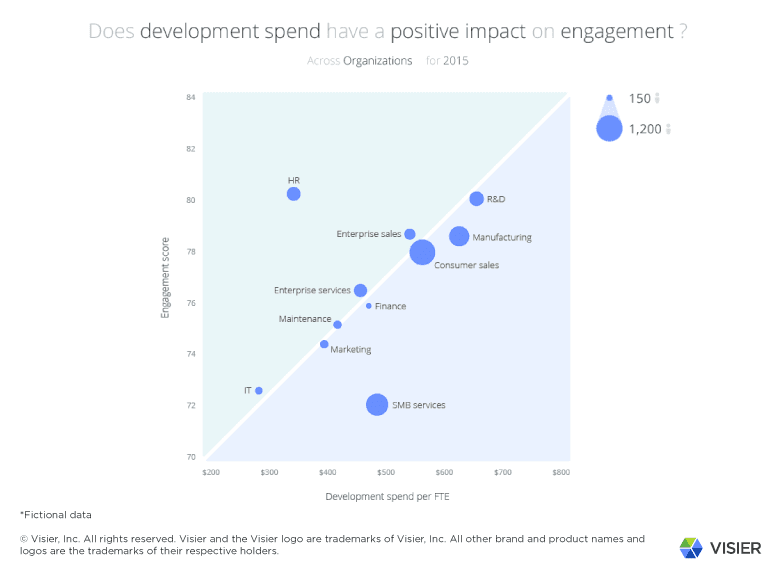When it comes to employee engagement surveys, you don’t always get what you pay for.
Consider this: Many years ago, a municipal organization I worked with in a previous role spent $150,000 on an employee engagement survey. The results were good and the report was nice to look at. But there was just one problem: nobody could do anything with the results!
Engagement was not linked to other critical indicators such as performance ratings, resignations, promotions, or instability of managers. It was hard to delve into the WHY of problems. As a result, the HR team couldn’t get the buy-in needed to develop key programs.
This story represents a common challenge many organizations continue to face when interpreting engagement data. And in spite of numerous innovations in engagement tracking, there is a huge gap between employee engagement data (even if it’s been effectively collected) and information about actual workforce outcomes, such as retention of key talent.
Furthermore, when engagement scores are presented as isolated metrics, HR can’t make the necessary link between engagement investments and key business outcomes. This is a major challenge because business leaders expect all functions within their organization, including HR, to know how the money they spend will impact overall results.
5 Steps
The key is to link employee engagement data with other critical indicators and make employee engagement-related decisions within the context of key business priorities. By following these five steps, HR can achieve this goal:
Step 1: Understand the business
To start, HR must figure out what the rest of the business is measuring. While we focus on headcount, turnover, time to hire, etc., the business will be thinking about revenue, profit, customer satisfaction, patient readmission rates, same store sales, cost per unit, and many other metrics. Your industry (and your company) will have their own core business metrics and it is important to understand what they are – and why they matter.
Step 2: Gather data from multiple sources
To unlock the value of engagement data, you need to combine it with other information, such as employee data from your HR management and performance management systems and business outcome data from your ERP, and bring all that data into a single system that supports broad, ad-hoc analysis. This way, you can connect your employee engagement data to things your business cares about, such as performance and profitability.
Step 3: Drill deep
If you see any red flags, drill deeper into the data to determine what is causing the engagement problem: Is it our approach to rewards? Do people feel they have a connection to the business? Are the right people being challenged by their work?
Be warned, however, that analysis is not the same as the production of static reports or dashboards. These are tools that simply monitor isolated metrics.
True analysis requires the ability to combine different metrics, different statistical processes, and different ways to share and display the data so that “analytic stories” – ones that answer critical business questions – can be told. True analysis should answer questions like: Does changing a team’s manager every year affect their level of engagement?
Step 4: Create a powerful story
Fashion the analysis into a story that shows, for example, how the rate at which managers change affects a range of engagement measures. Also, keep in mind that a best practice for effective analysis is to immediately answer follow-up questions or explore alternative interpretations of the answer. If you can’t answer the questions your audience has, your story won’t be compelling and won’t lead to changes in business practice.
Step 5: Get buy-in for critical programs
Finally, to get buy-in for the program from pivotal decision-makers, demonstrate how it will create business value.
As my colleague writes in this blog post, during Visier’s HR Leadership workshop, Dave Ulrich shared a little trick to achieve this: Include the phrase “so that” in every conversation with business leaders. Your statements will look something like this:
- We want to reduce resignations of pivotal employees in product design so that we can meet our product innovation goals.
- We have developed a plan to improve employee sentiment in our retail outlets by 10% so that we can improve customer satisfaction, which will increase profits by 2%.
At the end of the day, HR leaders who can succinctly demonstrate the connections between talent and business success are more likely to play a strategic role.
The Power of Contextualized Data
There are a number of potential engagement levers to pull (Deloitte recommends 20 specific practices), and what works for a tech company looking to spur innovation can be very different from an financial organization looking to improve customer retention.
HR leaders can navigate the many engagement program options in a very targeted, strategic way when engagement data is linked to other critical indicators and examined within the context of key business priorities. This ultimately helps HR leaders gain more buy-in from senior leaders and drive organization-wide change.
